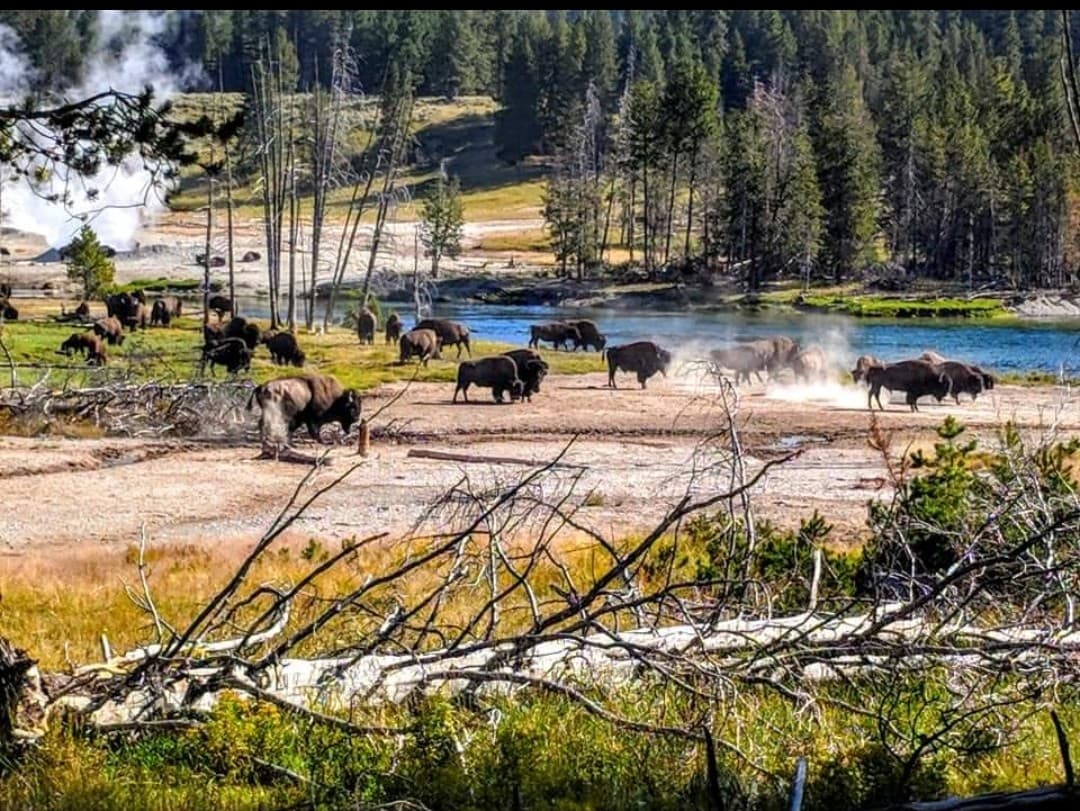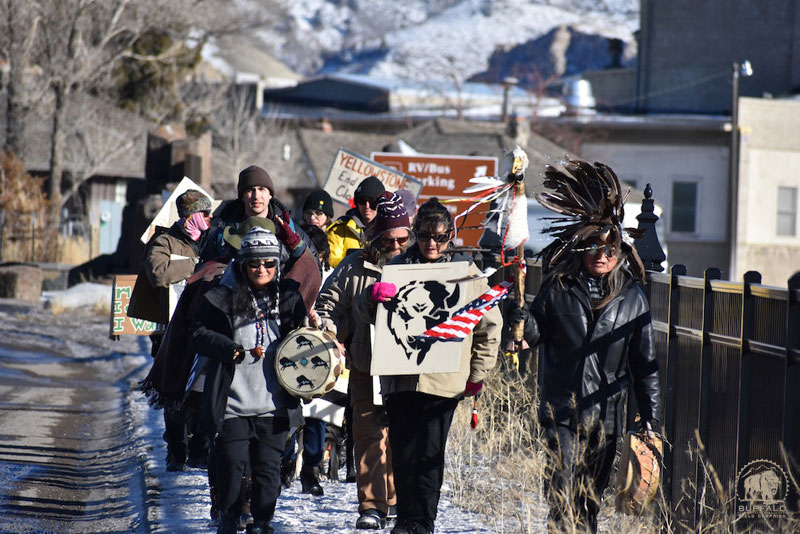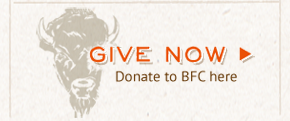Sign the Petition: Support Endangered Species Act Protection for Yellowstone’s Wild Bison Herds
What We Do
A Historic Tribal Buffalo Summit to discuss tribal co-management of the Yellowstone buffalo.
Decision Imminent
Advocate for an Environmentally Preferable Alternative
Act by July 8, 2024

Yellowstone National Park has released its’ final environmental analysis for a plan on how buffalo will be managed for years to come. The release starts a 30-day “waiting period” after which Regional Director Kate Hammond will make a momentous decision on the future of our country’s last wild buffalo herds.
What you can do.
Contact Kate Hammond and Cam Sholly before July 8.
Kate Hammond, Regional Director National Park Service
12795 West Alameda Parkway
Denver, CO 80225
(303) 969-2500
This email address is being protected from spambots. You need JavaScript enabled to view it.
Cam Sholly, Superintendent Yellowstone National Park
Attn: Bison Management Plan
PO Box 168
Yellowstone National Park, WY 82190
(307) 344-2002
This email address is being protected from spambots. You need JavaScript enabled to view it.
Urge the Regional Director and Superintendent to create an “environmentally preferable alternative” that causes the least damage to, and best protects wild buffalo and the Yellowstone ecosystem by:
- Managing wild buffalo like wild elk. Cease costly and wasteful government management actions.
- Getting Yellowstone National Park out of the business of harassing, trapping, domesticating, and slaughtering wild buffalo, which suppresses the herds, and impedes migration to National Forest habitat.
- Safeguarding genetic diversity by conserving at least 2,000 to 3,000 adult buffalo in each herd. More must be done for the Central herd whose numbers have been perilously low since 2008.
- Independently studying genetic variation and herd integrity, and how “management” factored in changing Yellowstone’s population structure from “genetically distinct bison subpopulations” to “one interbreeding population.”
- Implementing projects with the Custer Gallatin National Forest and American Indian Tribes to restore connectivity to habitat, and respecting buffalo’s freedom to roam National public trust lands.
- Building infrastructure for wildlife safe passages.
Background
In January 2022, Yellowstone National Park published a notice asking for public scoping comments on a new bison management plan that reflects all of the changed circumstances and the best available science since the outdated plan went into effect in 2000. The Park’s notice also terminated an attempt, begun in 2015, to write a new plan with the State of Montana. BFC submitted detailed comments and a proposal asking that the public be given a chance to comment on an alternative to manage wild bison like wild elk. Download BFC's scoping comments from February 28, 2022 (PDF).
In August 2023, Buffalo Field Campaign and Western Watersheds Project collaborated in developing joint comments on the Park’s draft plan which can be downloaded here: BFC and WWP Comments Yellowstone National Park Bison Management Plan Draft EIS, September 20, 2023 (PDF 614kb)
Read Yellowstone National Park’s Final Environmental Impact Statement, June 2024 (PDF)
Read Yellowstone National Park’s Draft Environmental Impact Statement, August 2023 (PDF)
Read Yellowstone National Park's newsletter, January 2022 (PDF)
Read Yellowstone National Park's notice in the Federal Register, January 2022 (PDF)
Go to Yellowstone National Park's Bison Management Plan web page.
In the News
National Park Service asks for input on draft bison management plan, Yellowstone Public Radio, August 14, 2023
Learn more on our web page:
From our inception in 1997, Buffalo Field Campaign (BFC) has fostered relationships with indigenous people. The late Rosalie Little Thunder, Sicangu Sioux, was our Co-founder and guide. Rosalie’s wisdom guided us with a vision, and her knowledge gave us a mission to protect Brother Buffalo. The Campaign honors the historic and vibrant connection buffalo and indigenous peoples share. We respect tribes and appreciate the commonalities we share regarding sacred Buffalo. The Campaign continues to engage with tribes as we strive for positive change in the lives of the only continuously-wild herd of buffalo in the contiguous United States.
Today, our relationships with tribes and indigenous people are diverse and take place in many different arenas. Most significantly, we support tribal sovereignty by advocating for tribes to assume leadership within the Interagency Bison Management Plan arena. The voices of too many tribal nations are being silenced by the overwhelming roar of existing mismanagement. It is time to strive for a holistic approach. There are tangible, common sense solutions to the problems Yellowstone buffalo face. Huge swathes of the Yellowstone Ecosystem lie vacant, kept from the buffalo. Those buffalo that choose to walk it are harassed and/or killed.
During these times of severe climate change impacts to the landscape, global wildlife extinctions, and the mass repealing of federal environmental protections, Yellowstone buffalo must be centered. It is time to call for the opening of the suitable habitat outside Yellowstone National Park boundaries, and the significant increase of bison populations across the region. Tribes, on the landscape since time immemorial, have the most to lose with their sacred relationship with buffalo. The Campaign believes tribes must have a central role in remedying Yellowstone buffalo mismanagement. We’ll continue to honor our late co-founder, and embrace our historic ties to indigenous people in this way.
Co-founders of BFC Rosalie Little Thunder and Mike Mease
Learn more about the Buffalo Field Campaign Here
Some of Our Work With the Tribes
An Open Letter to Tribal Leaders & the American People
First Annual Rosalie Little Thunder Memorial Walk
Third Annual Rosalie Little Thunder Memorial Walk
BFC Welcomes New ED, James Holt
Montana-Wyoming Tribal Leaders Council Passes Buffalo Resolution
Traditional Ceremony Honoring Wild Buffalo on Horse Butte
Releasing of Buffalo Spirits Ceremony
From Yellowstone to Standing Rock: We are One for Buffalo and Sacred Waters
BFC Attends Ft. Belknap Pow Wow
Standing in Solidarity with Indigenous Allies
Governor Bullock to be honored by Native Leaders, Wild Buffalo Allies
Buffalo Wild
A powerful anthem to the wisdom of the buffalo.
Poem by John Trudell. Music by Good Shield and Mignon Geli.
BFC and Tribal Comment on the Custer Gallatin National Forest Plan Revision
BFC advocates for endangered species listing in the Yellowstone region
BFC Official comments Custer Gallatin National Forest plan revision, June 4, 2019 (PDF)
Northern Cheyenne Tribe, CGNF Forest Plan Revision-Species of Conservation Concern, May 28, 2019 (PDF)
Official Signatories’ Report, American Bison A Species of Conservation Concern, March 5, 2018 (PDF)
Crow Creek Sioux Tribe, CGNF Comment Yellowstone Buffalo, March 1, 2018 (PDF)
Piikani Nation, CGNF Innii Comment, March 1, 2018 (PDF)
Buffalo Field Campaign is requesting the state of Montana and Yellowstone National Park evaluate managing wild buffalo like wild elk on public lands in Montana.
The buffalo in Yellowstone are unique and distinct. They're the only wild, migratory herds surviving in their original territory and carry the wildlife species’ legacy for future generations and should be treated as such!
BFC has developed a cost-saving, common sense alternative to replace the costly, heavy-handed, tax-wasting, bureaucratic mess called the Interagency Bison Management Plan. This can be done once MCA 81-2-120 is repealed. MCA 81-2-120 transfered Montana Fish, Wildlife, & Parks authority to manage wild buffalo to the Department of Livestock. BFC presented our proposal to Montana’s Governor and Yellowstone National Park's Superintendent in June 2015.
Yellowstone is now taking public comment on the plan through Tuesday, October 10. Our goal is to get the public to comment and ask that BFC's alternative, Manage Wild Bison Like Wild Elk, Learn more about Yellowston'e bison management plan. The final Enivronmental Impact Statement is expected to be released in summer 2024.
Buffalo Field Campaign is requesting the state of Montana and Yellowstone National Park evaluate managing wild buffalo like wild elk on public lands in Montana as an alternative in the Bison Management Plan. The Manage Wild Buffalo like Wild Elk in Montana alternative supports buffalo’s freedom to roam America’s public lands.
The alternative would ensure wild buffalo are allowed to inhabit public lands and establish a population in Montana. Like wild elk, wild buffalo would be managed by hunting based on sustainable populations in available habitat in Montana.
The habitat to sustain a wild buffalo population exists on public lands in Montana. What remains missing is a commitment by Montana's Governor to allow wild buffalo to inhabit National Forests and other public lands beyond Yellowstone National Park.
As practiced by the state of Montana and Yellowstone National Park, adaptive management has been a dismal failure. Despite several changes to the plan, the framework continues to operate on faulty assumptions and outdated information. The public has roundly criticized adaptive management and an independent review by the U.S. Government Accountability Office found fundamental problems that persist to this day. We strongly encourage using the best available science to guide informed management decisions.
The Manage Wild Buffalo like Wild Elk in Montana alternative meets the mandate from the U.S. Congress to conserve and leave buffalo “unimpaired for the enjoyment of future generations.”
The alternative adheres to National Park Service policies and directives requiring that “natural values, processes, systems, and values” be preserved. The alternative also fulfills Montana’s public trust responsibilities for “each generation as trustee of the environment for succeeding generations.”
It is long past time for the state of Montana and Yellowstone National Park to transition away from a destructive and costly management plan to a sustainable and respectful plan for wild buffalo.
The alternative to manage buffalo by hunting based on sustainable populations in available habitat in Montana is a viable alternative that fits the four corners of a sound wildlife management plan. But it requires that the state of Montana and Yellowstone National Park reject continued slaughter of buffalo.
Government slaughter of buffalo eliminates wildlife management of the migratory species. The government must reject slaughter as a bygone policy relic from the 1870s. Hunters do not want to be a management tool in the toolbox of another government slaughter plan. Subsistence hunting for hunters and their families must also mean subsistence for the wild species taken by managing habitat to sustain a wild buffalo population over the long-term.
The alternative proposes continuing the Designated Surveillance Area management of cattle in place of an Interagency Bison Management Plan.
Despite several incidents of Montana cattle testing positive for Brucella abortus, the Designated Surveillance Area has protected producers statewide. Several taxpayer-supported programs are in place to assist producers in managing cattle. Producers in the Designated Surveillance Area are compensated for testing, vaccination, and handling of cattle. In the vast Yellowstone ecosystem, managing cattle remains the most effective disease risk management approach. Ranchers statewide have saved $5.5 to $11.5 million annually since the Designated Surveillance Area went into effect in 2010. These benefits will continue to accrue for livestock producers under the alternative to Manage Wild Buffalo like Wild Elk in Montana.
The Manage Wild Buffalo Like Wild Elk in Montana alternative will also save millions of taxpayer dollars because it limits unnecessary government action by ending government capture of buffalo for slaughter, quarantine, hazing deadlines, population control experiments, and vaccination.
Montana and American taxpayers expect transparency and a public accounting for how our money is spent by the government. It should not require a report by the U.S. Government Accountability Office to arrive at an estimate of how much taxpayer money is being spent on the Interagency Bison Management Plan. Cost to taxpayers and cost effectiveness are issues that need to be disclosed in your evaluation. Buffalo Field Campaign requests the government publicly disclose management costs annually so the public has an opportunity to gauge the cost effectiveness of management actions.
As you know, Montanans strongly support restoring wild buffalo in the state, a purpose and need embodied in our alternative. More than three in four Montanans support restoring wild buffalo on public lands. More than seven in ten want to see wild buffalo managed like wildlife not livestock. Just as many Montanans want management decisions to be made by biologists and scientists rather than politicians. The pro-wild buffalo sentiments of Montanans are also found locally in the very communities that make their livelihoods here.
The transition to a sustainable and respectful wildlife management plan aligns with the economic and social values of Yellowstone’s gateway communities. Americans and people worldwide are entitled to see and experience the wild buffalo the state of Montana touts in its Office of Tourism advertisements. However, unless Montana changes its policy, the opportunity to experience seeing buffalo in their original habitat will remain restricted to Yellowstone National Park in the state of Wyoming.
The people of Montana and America deserve an honest and public evaluation of our alternative. Please evaluate managing wild buffalo like wild elk on public lands in Montana as an alternative in the Bison Management Plan.
MONTANA MANAGE WILD BUFFALO LIKE WILD ELK
Managing wild buffalo like wild elk in Montana, cover letter (PDF 510kb).
Managing wild buffalo like wild elk in Montana, Executive Summary (PDF 155kb).
Managing wild buffalo like wild elk in Montana, Proposal (PDF 898kb).
Buffalo Field Campaign’s Freedom of Information page is an open access portal to public records we sought, fought for, and have disclosed here about how government decisions are affecting our country’s last wild buffalo in Yellowstone.
Please check back for updates. More records will be added to BFC’s Freedom of Information page so you can stay informed as a critical voice in holding our government accountable.
NEW! BFC secures release of Yellowstone National Park records
Yellowstone National Park records (285MB zip file).
Buffalo Field Campaign’s Freedom of Information Act appeal (February 20, 2024) (1.8 MB).
Washington D.C. Freedom of Information Act Office appeal decision (March 27, 2024) (98kb).
BFC lawsuit shows Yellowstone is managing bison “like cattle on a ranch”
Buffalo Field Campaign won our Freedom of Information Act lawsuit against Yellowstone National Park Superintendent Cam Sholly’s office. The court ordered release of records the park sought to withhold from the public can be found in the zip folder below. You can read the judge’s opinion and order here: U.S. District Court Judge Donald W. Molloy Opinion and Order (July 7, 2020) (13.4 MB). Judgment (July 7, 2020) (41 kb).
Here are excerpts from two noteworthy records Yellowstone National Park did not want disclosed to the American people.
"The Superintendent was informed that the Secretary of the Interior wanted (1) Yellowstone bison managed more actively like cattle on a ranch, and (2) the Bureau of Land Management to conduct an assessment of the number of bison the park could support using the animal unit month (AUM) concept. This approach is traditionally used to manage forage use by grazing livestock."
"The current management approach for Yellowstone bison is not serving the broader common good, but rather specific livestock interests based on perpetuated myths and misperceptions. The lack of tolerance for wild bison on more suitable public lands in the Greater Yellowstone Area is no longer justified based on the comparative risks of brucellosis transmission to cattle, human injury, and property damage; all of which are much higher for wild elk that are tolerated without substantive management."
P.J. White, Rick Wallen, & Chris Geremia, Resolving Intractable Governance Issues to Recover Wild Bison While Maintaining Public and Tribal Trust, (Yellowstone National Park, Mammoth, Wyoming) (unpublished manuscript, March 14, 2018) (2.7MB PDF).
Buffalo Field Campaign v. U.S. Dept. of the Interior, National Park Service
Buffalo Field Campaign prevailed in our Freedom of Information Act lawsuit to disclose public records from Yellowstone National Park Superintendent Dan Sholly’s office about the Yellowstone bison population.
Contents of zip archive (48.1 MB): BFC’s appeal and complaint; the Administrative Record of the case; Kerrie Evans NPS Declaration; Vaughn Index; three productions of records; court-ordered production of records.
Buffalo Field Campaign v. U.S. Dept. of the Interior
Buffalo Field Campaign prevailed in our Freedom of Information Act lawsuit to disclose public records from former Secretary of the Interior Ryan Zinke’s office about the Yellowstone bison population.
Contents of zip archive (172.1 MB): BFC’s complaint; eleven productions of records.
Buffalo Field Campaign, Friends of Animals, & Western Watersheds Project v. U.S. Fish & Wildlife Service
Endangered Species Act litigation to advance our petition to list the Distinct Population Segment of Yellowstone bison as threatened or endangered with extinction.
Contents of zip archive (437.1 MB): Plaintiffs’ complaint; the Administrative Record of the case; U.S. District Court Judge Christopher R. Cooper’s bench opinion.
Buffalo Field Campaign v. U.S. Dept. of Agriculture Animal and Plant Health Inspection Service
Freedom of Information Act litigation involving the federal livestock overseer’s population control study of GonaCon, a chemical sterilant used on bison taken under permit from Yellowstone National Park.
Contents of zip archive (1.85 GB): BFC’s FOIA request and complaint; case management orders; nine productions of records.













